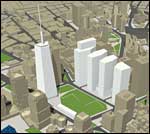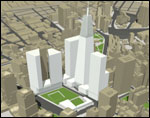What's Next For Civic Groups
Last year, the architect and planner coalition New York New Visions created a special committee to review all of the proposals for the World Trade Center site, from the panned designs in July to the nine acclaimed designs in December. But now that officials have selected Daniel Libeskind's design for Ground Zero, the committee has no plans to disband.
New York New Visions, along with the other dozens of civic groups that have formed after September 11, will continue to keep a close eye on the 16-acre World Trade Center site and beyond, and keep working to influence how New York City is rebuilt.
Even groups that Libeskind's design would seem to make utterly obsolete, like the rebuild-the-towers advocates Team Twin Towers and the World Trade Center Restoration Movement, are vowing to keep up the struggle. "If you believe as I do that something more like the taller original Twins is better, then keep fighting to have that built instead!" posted Louis Epstein on Gotham Gazette's message board about the chosen plan.
There is also a completely new group called Voices of Lower Manhattan that is just getting started this month.
Rebuilding civic groups say that there is much more to be decided, and are gearing up for new publications and projects. Some will be fighting to protect the design that Libeskind envisions, others to influence its details, and to capture unspent federal rebuilding aid for causes like jobs and affordable housing.
DEBATING THE DETAILS
With the glaring exception of the rebuild-the-towers advocates, most of the rebuilding civic groups supported Libeskind's design as the best choice for downtown. Now, said Rick Bell of New York New Visions, they will be focusing on the details of Libeskind's design for Ground Zero that remain up in the air. One major question, Bell said, is exactly how many retail stores are located underground. New York New Visions, the coalition of lower Manhattan residents, businesses and architects Rebuild Downtown Our Town and others have said that it is important that stores are not just underground in a mall, but also along the streets so that downtown becomes a lively shopping area.
Rebuild Downtown Our Town, nicknamed R.Dot, plans on fighting to preserve as much of Libeskind's vision as possible, said director Beverly Willis. "We see R.Dot as active as long as the issues that we are concerned about have not been resolved. We are incredibly concerned about the deterioration of Studio Libeskind's design," she said. "We were dismayed with the changes that were already made without public input between the original design and the one that was chosen." These changes, Willis said, include putting more office space in the 16-acre World Trade Center site itself.
One of the World Trade Center site debates that are still unresolved is whether or not West Street will be tunneled underground. In the Februrary 27 presentation of his design, Libeskind showed two possible plans for West Street. In one, four blocks of West Street along Ground Zero are brought underground. In another, the street is lined with trees, but still open to traffic at street level. R.Dot and another group created specifically around this issue, the Coalition to Save West Street, will be pushing to keep West Street above ground as a final decision is made about the road.
Residents and victims family members are also in tense debates about rebuilding officials' proposal to put a bus terminal underneath the memorial space at Ground Zero, and whether or not all of the unidentified remains from the disaster should be interned in a tomb at the World Trade Center site.
KEEPING THE PUBLIC INVOLVED
Development corporation officials have said that they plan to choose a design for the 9/11 memorial by the second anniversary of the attacks. As this decision draws closer, the Municipal Art Society project Imagine New York will work to set up meetings and forums for the public to give their input about the memorial, said director Holly Leicht. "Imagine feels very strongly that the public needs to have a part in that process," said Leicht. "We are hoping that there will be a short list of finalists that the public can weigh in on." This spring, Imagine New York will also hold workshops with the public about transportation and preserving historic buildings in lower Manhattan.
Rick Bell said that New York New Visions will also be involved in planning for the memorial, and will work to ensure that the memorial is built with the "greatest amount of public participation and greatest amount of creative splendor." Bell said that it is important that the memorial be chosen by an independent jury, but also that the jury take into account the opinions of victims families and others closely involved.
Civic Alliance, the umbrella group of civic groups involved in rebuilding, hosted a large public town hall meeting for 5,000 people called Listening to the City in July 2002. Many have called for another big public forum, but the group does not plan to hold a similar event during planning for the memorial, said Petra Todorovich of the Regional Plan Association, the organization heading up the Civic Alliance. "We still feel that public input is a very important part of the process, but aren't able to host a big event like Listening to the City. We were unable to get the support of public agencies or get the amount of funding needed."
But the Civic Alliance will continue to be involved, especially as steps are taken to implement the mayor's plan for downtown, said Todorovich. "We're in this for the long run," she said. "The more that the process itself it is successful, the less proactive we will be. but there will always be a need for people to come and reach a good portion of the civic community."
FIGHTING FOR THE MONEY THAT'S LEFT
Other groups will continue to watch how what is left of over $21 billion in federal rebuilding aid given to the city after the attacks is spent. "The city is in a very serious recession, joblessness is at historic high points, and there's $1.25 billion in money sitting in the bank at the Lower Manhattan Development Corporation, that is supposed to be economic development money," said David Kallick, head of the Labor Community Advocacy Network, a coalition of advocacy groups. "The time has come for this to be a central point of discussion."
The coalition that Kallick heads has several suggestions for where the money should go, listed in a new report. One of the group's major recommendations, Kallick said, is that officials spend $1 billion of the federal aid that is still in the development corporation's coffers to create $50,000 new jobs. Kallick said that the federal aid was given to the city as part of an economic development package, to help New Yorkers economically recover from the attacks. However, city officials have suggested that the money be spent on downtown infrastructure or the 9/11 memorial.
The coalition will also continue to monitor how the remaining billions in tax-free bonds, called Liberty Bonds, which were given as part of the federal 9/11 aid are spent. Hundreds of millions have already gone to fund largely market-rate housing in lower Manhattan, despite calls that some apartments should be set aside for lower and middle income New Yorkers.
Although many of the federal programs to help people clean up the air and dust from the attack in their apartments are now over, groups like 9/11 Environmental Action are lobbying the state and city to fund health programs, and even planning an environmental summit.
IN IT FOR THE LONG RUN
As more and more decisions are made, civic groups are hoping that at the connections they have made during the past year and a half will pay off. The Labor Community Advocacy Network and other civic groups met with Libeskind in the months leading up to the official selection of the architect's plan for downtown, and hope that the man that the New York Observer has dubbed "Mr. Ground Zero" will continue to be so accessible. "We've already talked with them about continuing meetings. I really felt like he and his wife understood that the public needs to be a partner in the process, and treated us as representing meaningful constituencies in the public," said Kallick. "That felt very nice."
The First Six Plans
The Lower Manhattan Development Corporation unveiled their first six plans for the World Trade Center site on Tuesday, July 16. Here are their proposals. Click on the plans below to find out more about each one.
 |
 |
 |
||
| Memorial Plaza | Memorial Square | Memorial Triangle | ||
 |
 |
 |
||
| Memorial Garden | Memorial Park | Memorial Promenade | ||
World Trade Center Site: Next Steps
The new president of the Lower Manhattan Development Corporation, Kevin Rampe, delivered a speech about the next steps for the World Trade Center site at a Downtown-Lower Manhattan Association Forum on March 20. Below is a transcript of his remarks.
Before I begin, allow me to reflect for a moment on events taking place thousands of miles away, but nonetheless relevant to our work here in lower Manhattan. With the outbreak of war, we are reminded of the high purpose to which all of us have dedicated ourselves in the aftermath of September 11th. Lower Manhattan has come to symbolize not only the devastation of terrorism, but the depth of our resolve to overcome it. And as our nation meets a new challenge, I think it is appropriate we come together this morning and renew our pledge to rebuild.
I also want to thank the Downtown Alliance for hosting this event. Before and after September 11th, the alliance has been lower Manhattan's strongest advocate, fighting to ensure that this community reaches its greatest potential. You have been a terrific leader in the rebuilding effort.
Last month, we achieved a critical milestone - the selection of Daniel Libeskind's design, memory foundations. His inspiring plan envisions the World Trade Center site as a place where loss is remembered and life is celebrated, reconciling what had seemed an impossible contradiction. The selection of the plan marked the end of one phase of the rebuilding effort - the laying of a foundation - and the beginning of a new one. It also provided an opportunity to assess the progress we've made and to chart a new course for the future.
Over the next several months, the Lower Manhattan Development Corporation will focus on four principal areas as we carry out our mission:
- planning on the World Trade Center site and the creation of a fitting memorial;
- coordinating the creation of a 21st century transportation infrastructure;
- developing initiatives to revitalize lower Manhattan beyond the World Trade Center site;
- and allocating the remainder of federal aid in support of the revitalization effort
the first and most pressing issue we must address is how to proceed with on-site planning now that a design has been selected. The Port Authority and Lower Manhattan Development Corporation are equally committed to ensuring that Libeskind's vision is realized. Today, I'm pleased to announce that the Lower Manhattan Development Corporation and Port Authority are reaffirming the historic partnership we entered into last year. That partnership brought us to a single plan. It will now transform the plan into a reality.
The Lower Manhattan Development Corporation and Port Authority will jointly retain studio Daniel Libeskind as the master design architect. In this role, he will be directly involved with all aspects of planning for the site, with each agency taking the lead on specific issues.
With respect to the memorial and cultural district, and the public outreach process, the Lower Manhattan Development Corporation will take the lead. In fact, Libeskind is already working with the Lower Manhattan Development Corporation and its consultants to prepare the international competition for the memorial, which will begin this spring. Details of how the competition will be structured and how a design is to be selected will be announced within the next few weeks.
With respect to on-site transportation facilities and infrastructure planning, the Port Authority will take the lead. And with respect to refinement of the master site plan, the Port Authority and the Lower Manhattan Development Corporation will jointly retain Libeskind - continuing the same partnership that produced the design. To ensure that the site is developed in a manner consistent with Libeskind's vision and the principles adopted during the design competition, the Port and the Lower Manhattan Development Corporation will jointly retain Libeskind - and working in partnership with the city, the state and the leaseholders to develop commercial design guidelines. These guidelines will bind all future commercial development on the site, ensuring we adhere to the highest standards of safety and excellence.
This partnership also sends a clear message to businesses, downtown residents and the entire nation: Daniel Libeskind's vision will be realized, and his hand will guide the way. I want to personally thank Joe Seymour for his leadership and vision from the very beginning of the rebuilding effort. No one has done more to advance the revitalization of lower Manhattan than Joe Seymour. His work in lower Manhattan is a model for public service - thank you Joe.
The second area Lower Manhattan Development Corporation will focus on is transportation. Even prior to September 11th, lower Manhattan's antiquated transportation infrastructure had placed it at a disadvantage with other commercial areas. The attack worsened an already difficult situation, interrupting service for months on several subway lines and displacing tens of thousands of path commuters until this very day. Although lower Manhattan is the third largest central business district in the nation - it has no direct rail or airport access. And while numerous north-south subway lines serve lower Manhattan, they are not well-integrated from west to east, making a seamless commute very difficult.
Thanks to $4.5 billion in federal aid, that's all about to change. Governor Pataki has outlined several projects to transform lower Manhattan's transportation infrastructure into a 21st century system. The projects include a new station on the site akin to grand central, which would link to a new MTA station at Fulton and Broadway via an underground concourse. The new MTA Fulton transit center would rationalize a convoluted web of 13 subway lines. As a result, all of lower Manhattan's transportation lines would be integrated into one seamless system. The governor's priorities also call for airport access. In the near future the Lower Manhattan Development Corporation, in partnership with city and state transportation agencies, will release a transportation report for lower Manhattan. One thing however is clear, transportation improvements, a direct rail link to the airports in particular, are the most vital public investment we can make for lower Manhattan's future.
While the World Trade Center site will serve as a catalyst for a renewal throughout lower Manhattan, much remains to be done to harness the optimism the plan has unleashed. The September 11th attacks took more than twenty seven hundred lives and destroyed the World Trade Center, but the effects radiated far beyond the 16 acres, impacting communities from Chinatown to Tribeca, SoHo to the financial district. In order to address the lingering effects of September 11th and spark a broader revitalization, the Lower Manhattan Development Corporation will pursue several off-site initiatives. Fortunately, Mayor Bloomberg provided a blueprint to revitalize lower Manhattan last year when he released a vision for lower Manhattan - our off-site planning efforts will be consistent with that blueprint.
Over the next several months, we will continue to work in partnership with Deputy Mayor Dan Doctoroff to pursue those initiatives. Examples include easing traffic congestion in Chinatown brought about by heightened security; increasing the mix of uses on Fulton Street to create a new east-west retail and entertainment corridor in lower Manhattan that stretches river to river; increasing open spaces downtown to provide a more welcoming environment for families; or increasing the housing stock, making lower Manhattan into a true, 24-hour, 7 day a week community.
It is an ambitious agenda, but an achievable one. Lower Manhattan Development Corporation is unique among planning agencies because, while private capital will be critical to fully achieving our vision, we actually have the resources to make targeted public investments that will trigger the commitment of private capital. In the coming months, the Lower Manhattan Development Corporation will work to allocate the remainder of the $2.8 billion in federal aid that congress appropriated. The success of Lower Manhattan Development Corporation's residential grant program, which is credited with normalizing the vacancy rate downtown, is a testament to the positive impact federal aid can have on the revitalization effort. The remainder of the funds can be used for such purposes as building critical infrastructure, improving the quality of life or providing funding for projects when other sources fall short.
These are the four areas Lower Manhattan Development Corporation will address in the months ahead. When completed, they will have brought us much closer to fulfilling our mission: revitalizing lower Manhattan and restoring faith in the future of this great community.
Daniel Libeskind has supplied the vision; the Lower Manhattan Development Corporation and Port Authority will supply the resources and the resolve to make it a reality. And when cynics argue that ultimately, Libeskind's plan will not look exactly is it does today, I cannot disagree: as Daniel often says, it will look even better!




